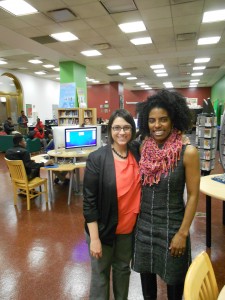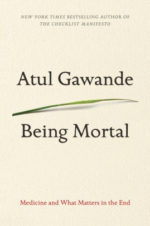Chicago Library Provides Example of High-Tech and High Touch. Is L.A. Ready For This?
Posted on | December 18, 2013 | Comments Off on Chicago Library Provides Example of High-Tech and High Touch. Is L.A. Ready For This?
Brandon Towns was having trouble opening his MacBook to show me the movie he’d made because his fingers were sticky with the glue he was using to make a paper maché mask.
Both sticky fingers and the Macbook capture the essence of YouMedia, the 5,500 square foot space in the Chicago Public Library where Towns and I met. It’s a high-tech and high touch place for engaging and motivating students, trying to get them sticky with learning.
For the MacArthur Foundation, which funded YouMedia, and for a growing group of educators, the space is a physical representation of a more profound form of learning than that represented by the current teach-and-test regime.
As Connie Yowell, director of education at the foundation, says: “We really think that part of what’s wrong with the current education system, and why people talk about it as broken, is that it is fundamentally starting with the wrong question. The education system now often starts with the question of outcomes: what do we want kids to learn?…. Our core question is ‘what’s the experience we want kids to have?’ So, the core question is around engagement.”
For Towns, and an estimated 300-500 students a week, YouMedia represents a safe place to go after school: somewhere to hang out, mess around, and to geek out. These terms were coined by Mimi Ito and her collaborators in their book about how kids engage digital media. The physical layout of YouMedia was designed with spaces that invite each activity.
Comfortable chairs and couches occupy the space near the door watched over by a friendly security guard. Eight teen-age girls crowd the conversation nook. Further down the room, students worked at tables and computers. Five young men crowded into the soundproof recording booth. At the end of the room, Towns sat huddled with his mentors, working on the mask that will be incorporated into his next film.
Towns is geeking out. He is part of the 22 percent of YouMedia users who come together with the adult staff to create something or connect youthful interest with academic learning. A student at King College Prep Academy, a Chicago Public Schools magnet, Towns has been making movies since he was 10. “The Struggle is Real” is a two-minute reminder that food insecurity dogs the lives of many Americans. And here is the trailer for his upcoming film featuring the mask he made.
Tags: Atrienne Strock > Brandon Towns > Chicago Public Library > Connected Learning > Connie Yowell > MacArthur Foundation > Sybil Madison-Boyd
LAUSD viewing IPads as Key to Common Core
Posted on | December 8, 2013 | Comments Off on LAUSD viewing IPads as Key to Common Core
I have been in Chicago this week. My colleague David Menefee-Libey, professor of politics at Pomona College reports on this discussion of LAUSD’s iPad purchase program and its relationship to the Common Core of standards.
Wednesday evening I attended KPCC’s panel discussion “Tech in the Classroom: How Much is Too Much?” at their Crawford Family Forum studio in Pasadena. Moderated by their Education Editor Evelyn Larrubia, the panel included Dr. Bernadette Lucas of Los Angeles Unified School District, Prof. Patricia Burch of USC, and Prof. Nancy Cheever of Cal State Dominguez Hills.
Lucas, Director of the Common Core Technology Project at LAUSD, was on the hot seat for the night, largely because of public controversies surrounding the Common Core nationally and the roll out of the iPad program locally. Larrubia asked more questions of her than the other two panelists, focusing primarily on the iPad program. What are the big ideas behind it? How is it supposed to work? How is it actually working? I’d urge you to follow the link and watch the program if you’re interested.
Leaving aside the popular controversies, which readers can easily follow elsewhere, two big things from the panel stood out for me.
One is that Lucas spoke in ways that convince me the district sees the iPads (“1 to 1 devices” in district jargon) as thoroughly embedded in the broader chain of ideas of standards-based education that has organized the most influential school reform efforts of the past twenty years here and nationwide. These ideas and their jargon are familiar to most of us. Each component of the system is supposed to link to the next in a coherent chain, roughly this way: educational goals ->> content standards ->> curriculum and materials ->> pedagogy and instruction ->>assessment ->> reporting and accountability ->> intervention.
LAUSD decision-makers apparently see the iPads in several – perhaps all – links of the chain. The devices will contain the standards-based curriculum now conveyed to student in textbooks. The district claims this content will take new forms, enabling (or requiring) teachers to develop and use new instructional strategies adapted to the needs, abilities, and interests of each individual child. The devices will also be used for the computer-delivered assessments required by the new Common Core (though iPads lack the keyboards required for Common Core testing). Teachers and schools will upload assessment data from each student’s device, data the state will pull together to assess and hold accountable each student, teacher, school, and district in the Brave New World of Common Core teaching and asssessment.
In short, the iPads are not just some shiny new toy. For LAUSD, they are integral to a whole new way of organizing the district’s entire educational program. We shouldn’t expect the district to give up on the program any time soon.
The second big idea of the night at KPCC was caution about the first big idea. Burch, of USC’s Rossier School of Education, talked about her forthcoming book, Privatization and Accountability in Digital Education and her own research on technology initiatives. She said there is as yet little research on the impact of “1 on 1 devices” on student learning.
Burch, while skeptical, did not dismiss the potential value of these new technologies. She was generous in her give-and-take with Lucas. From other research, she said, we know several things that would make the iPad program more likely to be successful, including teacher engagement, personalized instruction, interactive digital curriculum that doesn’t simply mimic print textbooks, and careful use of data. Each of these things will require careful attention and hard work from LAUSD and its teachers.
We now know a bit more about what to look for as the iPad rollout goes on. Kudos to KPPC for its initiative in sponsoring the forum.
Annotating the News 11/10/13
Posted on | November 10, 2013 | Comments Off on Annotating the News 11/10/13
Poorer than we thought. Using a calculation that factors in California’s relatively high cost of living, the state has the highest poverty rate in the country. According to Census Bureau, 23.8 percent of Californians live in poverty where the official poverty rate is 16.5 percent.
Even using the official calculation, a quarter of the state’s children live in poverty, a rate still somewhat lower than in the early 1990s, but thought to be increasing, this according to the Public Policy Institute of California. Child poverty in the state increased markedly in the Great Recession.
Teacher pension fund crisis getting closer. For at least a decade, the legislature and governors have ignored the shortfall in STRS, the state teacher pension fund. The shortfall—the difference between current contributions and future payments— totals $70-billion and grows by $22 million a day, this according to Channel 10. STRS predicts insolvency in three decades, a long time off in political terms. Yet, the cost of righting the system would be an additional state contribution of $4.5 billion a year, almost as much as the state spends on the entire CSU system.
The California legislature, like others in the country, can only kick this can down the road so far. Former L.A. mayor Richard Riordan and journalist Tim Rutten have suggested a federal insurance program. It would allow local governments to purchase guaranteed bonds that would stabilize their pension systems in exchange for fiscal discipline on the part of local governments and employee unions. Riordan’s ideas have been heavily opposed by employee unions, but his plan—or someone else’s—should be on the political agenda. Ignoring the elephant doesn’t make it go away.
A footnote to freshman English. Harper Lee, the author of To Kill A Mockingbird, is suing the museum in Monroeville, Alabama, where the novel is set and where she continues to live, at 87, in an assisted living facility. Lee claims that the museum has profited from her work and has not provided compensation. The Guardian tells the story in Southern gothic style with plot twists and twisted relatives. And did you know that Scout was really Truman Capote?
Tags: inequity > Poverty > teacher pensions
Annotating the News 11/1/13
Posted on | November 2, 2013 | Comments Off on Annotating the News 11/1/13
I’ve been away, so education periodicals have been stacking up on my desk, and on a balmy Friday night I am multitasking as I watch the USC-Oregon State game (Holy Cow! They won. Fight ON!)
K12 Inc. saw its stock price tank from a high of $37.85 to $17.60 after criticism by hedge fund manager Whitney R. Tilson, Education Week reported. By Nov. 1, it had rebounded to $18.47. After talking to K12 leaders, Tilson said he was convinced the company was “not evil,” not targeting students that were sure to fail, but that the program worked less well with challenging students than with those who had a college-educated parent at home tending to the home schooler’s lessons.
In our case study of CAVA, the California K12 charter management company, we came to similar conclusions. Virtual learning depended on a real parent or other supervising adult. The California schools suffered from a disconnect between its marketing arm and those delivering education. Despite some interesting innovations, it’s not an educational silver bullet.
•••
Inequality. Robert Reich’s new film Inequality for All deserves attention. I don’t know whether it will raise the social conscience about poverty the way An Inconvenient Truth did for global warming. But the toll of inequality on American families is immense, as is the strong tendency on the political right to blame the victims and indulge in chatter about government rewarding the lazy and undeserving.
So, is no wonder that schools are filling up with poor children. Child poverty has risen in every state. In 17 states, including California, students in poverty are a majority of students statewide, according to an analysis by the Southern Education Foundation.
Even the Economist has weighed in on the declining share of productivity gains accruing to labor (or in their case labour).
The political surprise is that declining incomes has created a war on the poor rather than a war on poverty.
(For a dramatic lesson, see Suzan-Lori Parks’ in the Blood, a retelling of the Scarlet Letter in which Hester is a welfare mother, who is systematically victimized by those who are supposed to be helping her. Claremont colleges students did an impressive job with difficult material in a Pomona College theater department production over the weekend.
•••
Education journalist John Merrow declared that he was finished writing about Michelle Rhee, this after he had trouble placing articles critical of her reign in Washington, D.C. But as I suspected, that didn’t last long. This week he weighed in on a report by Stanford University professors James Wyckoff and Thomas Dee found that the D.C. teacher evaluation system known as IMPACT was raising teacher quality.
Problem is, says Merrow, that no one correlated the evaluation system’s rankings with student performance. Chances are that a highly ranked teacher would be in an upper income area and lower ranked teachers would be teaching poverty students. Merrow doesn’t think the evaluation system is measuring teacher quality as much as it measures student poverty. “If you want to be a highly effective teacher in Washington, choose your students carefully! On the other hand, if you want to increase the chances of losing your job, teach poor kids,” he writes.
•••
Teacher Merit Pay. Texas has discarded its much-heralded teacher merit pay plan. The bottom line of the story was the bottom line of the state’s budget. Nearly half of Texas teachers boosted the achievement scores of their students enough to qualify for merit payments, and the state paid out $392-million in 2010-11. Too expensive said the state even though the schools with merit pay saw greater test score gains than those without.
One would have thought those market warriors in Texas would have applauded and doubled the incentives. But no.
The abandonment of merit pay is typical of the fate of merit pay plans. Historically, studies of these plans show that they are abandoned when the payout gets too large.
Teachers may not like merit pay plans for other reasons, but they should certainly be wary of their transitory nature.
Chicago’s Summer of Learning a good tryout of Learning 2.0 or Connected Learning
Posted on | October 3, 2013 | Comments Off on Chicago’s Summer of Learning a good tryout of Learning 2.0 or Connected Learning
For many months I have been tussling with how to bring the kinds of learning made possible by the Internet revolution to reality. As I have written in the Los Angeles Times, Chicago has provided a demonstration project in which students earned 100,000 digital badges making, building, and experiencing learning with more than 100 organizations.
I like the Summer of Learning partly for nostalgia: Chicago’s institutions—the Field Museum, the Museum of Science and Industry, and the Brookfield Zoo—provided me some memorable growing up experiences. And in terms of education policy, this summer’s experiment provided a working example of what the MacArthur Foundation calls Connected Learning.
While using different descriptors, Connected Learning is quite similar to what I have been calling Learning 2.0. Read more
Tags: Chicago > David Labaree > Larry Cuban > MacArthur Foundation > Mozilla Foundation > Summer of Learning
Teacher-Run Schooling to Gain Attention
Posted on | September 3, 2013 | Comments Off on Teacher-Run Schooling to Gain Attention
Teacher run schools are due to get attention this year. Expect a concerted effort to bring them to public and policy attention. Work should start on what has been called a “text,” although it probably won’t be in book form at the outset. Teachers need to believe that running their own schools is possible, that they have someplace to take their nascent interest in self management, and that they have company in the journey. See this at EdSource.
Tags: Barnett Berry > Center for Teacher Quality > Ferris-Berg > Graba > Kolderie
Content is King; Hire Reporters as if your millions depend on it. They do.
Posted on | August 9, 2013 | Comments Off on Content is King; Hire Reporters as if your millions depend on it. They do.
Memo to Jeff Bezos:

I’ll get back to thinking about education tomorrow. Today, I’ve been following the news about my first occupational love, newspapering.
Jeff Bezos’ purchase of the Washington Post for $250 million this week has set the world of newspaper watchers a twittering. While there is much, largely vacuous, conjecture about the future of the paper’s editorial policies and its longevity in paper form—dead tree news—one thing is clear. Bezos will bring change. “I’m excited and optimistic about the opportunity for invention,” he wrote. Or as Michael Hiltzik commented in the L. A. Times, “He’s looking forward to turning the Post into a laboratory.”
Much of the chatter this week has come from web developers who see Bezos as transforming the paper from a mass medium to a scalable, personally tailored communication device, opening up new channels for connecting with readers. Others commented on his conflict of interest, including the $600-million contract with the CIA, as if most publishers don’t have complex financial arrangements that give them less-than-disinterested motives. But in all the talk of delivery, content was largely undiscussed, other than assurances that the editorial management of the paper would remain untouched, which is probably the least believable statement of the week.
Bezos knows, or will learn, content is king regardless of how news is delivered. The most essential investment Bezos can make is not web networks: it’s reporters and editors. Bezos is known for his long game—a willingness to invest in the future as he has at Amazon with very slim profit margins. The future needs content.
The turn from print to Internet underscores this essential truth. Where the content of a printed paper is constrained by the decline in display and classified advertising that has shrunk all newspapers, digital packaging and delivery is highly expandable. Revenue still needs to flow, but the marginal cost of producing and distributing more news is relatively low.
The largely unsung heroes of the newspaper world are beat reporters, who get to know segments of the community or the political world very well. Great city hall reporters have more institutional knowledge of the town than the mayor. The best education reporters know enough about how schools run and students learn not to be bamboozled by the superintendent’s sound bites. It has been the ranks of these reporters who have been thinned by the decline in metropolitan dailies.
Media stars get attention, and the the lore of WAPO is full of them. (See veteran critic and editor Henry Allen’s recollection of The Post that was.) But the underling craft of cultivating sources and of patiently developing stories is what creates loyal readers who become habitual customers, regardless of whether the instrument is a handheld device or a broadsheet.
So, while others are assured by Bezos’ pledge to keep hands off the newsroom, I am alarmed. Great editor-publishers see building reportorial capacity as their central hands-on job. And this is doubly the case when the nature of news itself is changing along with the medium of expression.
In “Austerity” Mark Blyth Traces the History and Politics of a Dangerous Idea
Posted on | July 12, 2013 | Comments Off on In “Austerity” Mark Blyth Traces the History and Politics of a Dangerous Idea
Mark Blyth took a career detour to be a co-editor of The Transformation of Great American School Districts. So it was with great anticipation that I read his new book, Austerity. I recommend it to educators as a valuable corrective to the belief that boosting educational standards will increase the life chances of American students and create a rocketship economy. For teachers, school superintendents, and education policy wonks, this book is more about you than you may think it is.
Blyth considers austerity—the economic policy of the United States and Europe since 2003—a dangerous idea, and through tracing its history and effect he provides powerful evidence for that assertion. It slows, not grows the economy. But for poor and working class children the news is worse: they will pay for the economists’ fairy tales with high unemployment and reduced social mobility.
For Blyth this gets personal. Born and raised in relative poverty in Scotland, a welfare kid and proud of the fact, he is now a professor of political economy at Brown University, an extreme example of intergenerational mobility. “What made it possible for me to become the man I am today is the very thing now blamed for creating the crisis itself: the state, more specifically, the so-called runaway, bloated, paternalistic, out-of-control, welfare state. This claim doesn’t pass the sniff test.”
So, in addition to a keen mind and knowledge that ideas drive institutions, Blyth tackled the economics of voluntary deflation as a way of fulfilling the academic’s calling to be what Blyth calls “the Bul*l*hit police.” So, reader beware, heading into the history of austerity as public policy propels one into a *hit storm.
Austerity is supposed to inspire business confidence because government won’t be sucking up available capital to issue debt or adding to the payments to service existing debt. Voting for austerity is a vote for productive investment instead of waste, and government stimulus only gets in the way, according to the dominant economic thinking. To which Blyth replies, “There is just one slight problem with this rendition of events: it is completely and utterly wrong, and the policy of austerity is more often than not exactly the wrong thing to do precisely because it produces the very outcomes you are trying to avoid.”
Despite the intuitive attractiveness of the idea that you cannot cure debt with more debt, it is also true that we cannot grow when we are all trying to be austere at the same time. When that happens, as it is, individuals respond by taking a pay cut to keep their jobs, just as hundreds of thousands of teachers have in the United States. The first thing they do, of course, is cut consumption. They may also cut their personal debt by paying down credit card balances. That shrinks the economy again.
Blyth takes his readers through the American and European “too big to fail” banking crisis that converted private debts and massive business failures into government debt. In the case of Europe these became large enough that they continue to threaten both national economies and the continued existence of the Euro. “The greatest bait and switch in history,” Blyth calls it as he traces its history as an economic idea and how it has worked in practice. Not well.
What does this have to do with education policy? In two respects, a great deal. First, a slow national economy hammers state budgets for schools and colleges. In a very real way, it has been teachers and kids who have bailed out the bankers. For teachers, it’s furloughs and wage give backs. For college students it’s higher tuition and student debt.
Second, austerity kills the “education dream story,” the idea that if parents can get their children to work hard in school and persist through college social mobility will result. While it is still true that college graduation markedly increases the chances for employment and economic self-sufficiency, it’s also true that the prospects for this generation of college students is not as great as it was for their parents. College is a riskier investment than it used to be.
When the faith in education falters, youth find other ways forward. In Europe, the Middle East, and North Africa, unemployment rates among college educated young adults fuels political instability. Could something larger and more potent than the Occupy movement take place in America? A glance at countries as diverse as Brazil, Egypt, and Sweden suggests that it could. Austerity could crash the very institutions it was intended to perpetuate.
* * *
Mayor’s pledge to boost summer jobs illustrates the possibility of city government and its limits. New Los Angeles Mayor Eric Garcetti has pledged to boost summer jobs for youth. It’s the right move. The city was able to provide fewer than 4,000 jobs last summer. But it also shows how limited this or any mayor is in wrenching the economy. City governments, unlike the national government, have to balance their books, and during hard or show economic times have no choice but to be austere.
* * *
See a review of Austerity by Paul Krugman in the New York Review of Books, by Lawrence Summers in the Financial Times, and links to other reviews from the Watson Institute at Brown.
Tags: Austerity > Mark Blyth
In the Orchard of Education Technology
Posted on | June 7, 2013 | Comments Off on In the Orchard of Education Technology
Amending a PACE Policy Brief:
I got in trouble at a meeting recently for repeating the opening assertion of the policy brief I wrote for Policy Analysis for California Education. [View or download brief] As the brief says, “education technology has always over-promised and under-delivered.” The assertion, which is reasonably backed up by history and research, drew critical comment from tech-enthusiastic teachers. That, they said, must have been some other universe, or at least some other classroom!
But, indeed, the tendency of technology policy to concentrate on buying devices or bandwidth is a problem. It substitutes the easy job of filling out purchase orders for the hard thinking and action involved in changing the learning system, and that is the potential we are offered by Internet-fueled technology.
After the brief went to press, I began to think about technology policy as an orchard.
First, pick the low overhanging fruit by investing in applications that help the most expensive and difficult parts of schooling, including Special Education, English Language Learners, and remediation.
Second—and this is the hard part—we should graft some new branches onto the existing tree of learning. Technology can provide a new learning infrastructure. Information, teaching, testing: all available direct to students, who are the real workers in the education system.
Third, we should trim back the intertwined roots of the institution. Many writers on technology see regulation as the singular solution to the advance of new learning modalities. I disagree. But there are some important changes that should be made.
We should gradually move away from “seat time” funding and toward paying schools on the basis of achievement. In my mind, this change is not so much an “accountability” requirement—“you don’t get paid till students can demonstrate they learned something”—as it is a productivity incentive, making it possible for students to move faster if they can without stigmatizing those whose progress is slower.
For a lot of students, high school and college could take seven years, not the eight or nine now required.
We should also move away from geographic exclusiveness. Existing school districts and teachers should be able to offer virtual learning, which I see as much more the distribution of courses and lessons than whole on-line schools, statewide, not just in the confines of their school district or in contiguous counties.
I hope you’ll read and comment on the brief itself, which is available free from PACE in pdf form. Technology policy is hard, and it will benefit from the thoughts of many contributors.
Tags: PACE > Policy Analysis for California Education
To Make Students Learn, Make Schools Smart First
Posted on | May 30, 2013 | Comments Off on To Make Students Learn, Make Schools Smart First
 I learned a thing or three on last Friday, and it’s taken me a week to digest it all. For reasons unknown, I was invited to meet with some very bright teachers who are advisors to the California Council of Science and Technology, the state analogue to the prestigious National Science Academy.
I learned a thing or three on last Friday, and it’s taken me a week to digest it all. For reasons unknown, I was invited to meet with some very bright teachers who are advisors to the California Council of Science and Technology, the state analogue to the prestigious National Science Academy.
The CCST has been wrestling with what to do about digital education, and the invited group of teachers, tech developers, and onlookers spent Friday exploring the efficacy of new modes of learning.
Although I was invited to talk (mostly I introduced a policy paper on technology just released by Policy Analysis for California Education), for most of the day I listened intently to the participants as they described how they used technology in their work and what those experiences were teaching them.
And here’s what I learned: Teachers and tech developers learn the most when there is rapid, reliable feedback about the efficacy of teaching and learning. This observation crosses platform and technology: new tech, old tech, or no tech. When the learning system builds in feedback, learners are better able to correct their mistakes and teachers are more effective in managing the learning process. Read more
Tags: Andrew Ng > CCST > digital learning > Mohammad Qayoumi > smart organizations





